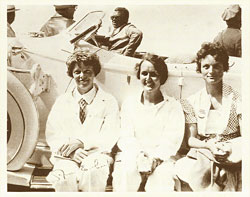
Air Derby Winners
Amelia Earhart, Ruth Nichols,Louise Thadden




Two days after the initial meeting, on May 15, 1928, Amelia was told that she had been selected as the woman commander of the upcoming transatlantic flight. Amelia had made it clear from the start that the role of mere passenger just for the purposes of publicity did not appeal to her and she requested an active role in the actual flight. She had no experience with multi-engine flying or with instrument flying, so it was agreed that, weather permitting, she would be allowed to fly part of the time.
The chosen aircraft was a tri-motor Fokker F7 named "Friendship." The plane was fitted with pontoons, equipment Amelia had never used. She only saw the plane once before their flight, as she was too well known around the airfields and couldn't risk starting rumors about the secret project.
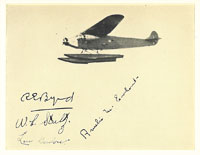
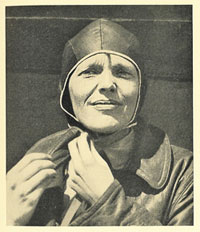
Her personal preparations were minimal. She packed a small knapsack with a toothbrush and comb, two handkerchiefs and a tube of cold cream. She also packed a borrowed camera, a pair of binoculars and a log book that had been a gift from her future husband, George Putnam, who was publicizing her flight. George also included a thermos of coffee, sandwiches and a crate of oranges.
Weather delayed the beginning of the flight from Boston to Newfoundland. Finally, on June 3rd, the Friendship took off for Trepassey only to be turned back by weather near Halifax, Nova Scotia. The next day, the Friendship and crew successfully landed in Newfoundland only to encounter gales or fog for days that prohibited their takeoff for Europe. The telegrams that follow tell the story of the wait.
George, knowing that Amelia had not packed a change of clothing wired:
SUGGEST YOU GO INTO RETIREMENT TEMPORARILY WITH NUNS AND HAVE THEM WASH SHIRT ETC --STOP
Amelia answered:
THANKS FATHERLY TELEGRAM NO WASHING NECESSARY SOCKS AND UNDERWEAR WORN-OUT SHIRT LOST TO SLIM AT RUMMY CHEERIO AE
After a week of anxious waiting, the weather cleared. The group of three, Amelia, Lou Gordon and Bill Stultz, made plans to begin their journey. They had received news that Mabel Boll was prepared to make the flight and indeed was ready to take off in the single engine plane called the "Columbia." On June 12, George sent three weather forecasts spaced an hour apart. Stultz tried for four hours to take the Friendship off, but was unsuccessful. The crew calculated the fuel as closely as possible as every ounce of weight counted.
With the competition close behind, alternatives were considered:
IF IN MORNING YOU CAN POSSIBLE TAKE OFF EVEN MINIMUM GAS IRELAND FAR BEST BET *STOP* SUGGEST TRY TAKEOFF AWAY FROM HILLS...IF THIS FAILS REDUCE GAS AND GO FOR AZORES SURELY NOTIFY ME SO ARRANGE GAS WEATHER REPORTS *STOP* PROBLEM THERE NAVIGATION DANGER MISSING ISLANDS HOPE YOU HAVE SEXTANT FOR OBSERVATION SENDING POSITION RADIO IF FORCED DOWN *STOP* MABEL SENDS WORD HERE NO START TOMORROW *STOP* WEATHER REPORT BOTH FOR IRELAND AND AZORES PM DARN SORRY BUT YOU WILL EMERGE ON TOP WE ALL KNOW YOU ARE DOING YOUR BEST
Finally, on June 17, favorable weather, seas and tides allowed the Friendship to take off after two unsuccessful attempts. Leaving no margin for error, they left with 700 gallons of fuel after originally planning to carry 850. Only a few villagers came to witness the takeoff after watching so many failures. Amelia later confided to George that that hour seemed to be the most dangerous hour of her life.
"Earhart Plane Soaring Over Atlantic; Reported Nearly Half Way to Ireland After Eight Hours" was the headline of the New York Times on the morning of June 18, 1928. However, the agreeable weather that allowed the take off of the Friendship did not last long. Soon, they were in thick clouds. They flew blind in the fog until sufficient fuel was burned to allow them to gain enough altitude to rise above the cloud cover. As dawn neared, they decided to descend to 5,000 feet where they flew in fog and rain once more. The radio was useless, so contact with ships and land was impossible. Although they had been flying by instruments, they were not sure of their position.

Just before 9 AM, Greenwich Mean Time, they spotted three ships on a course parallel to theirs. After some discussion, they decided to remain on course even though they calculated that by now they were down to an hour's fuel supply. The S. S. America, an oceanliner, appeared about three miles off course, so the crew detoured, using precious fuel, and circled the ship. Amelia scribbled a note and wrapped it in one of the oranges George had provided and dropped it in an attempt to contact the ship. The seas were too rough to attempt a landing, so the crew returned to the original course. Another long half hour passed before they spotted a small fleet of fishing boats. Then, in another hour, a gray shape loomed in front of them in the heavy mist. It was land! They flew along the coastline in an attempt to match land configurations to charts. Dangerously low on fuel, they had no idea where they were. Stultz decided to land.
They set down in moderate rain and taxied to a mooring buoy. In the distance, they saw a small town with houses and a muddy beach. Evidently, people here were not excited about an itinerant transatlantic aircraft. Eventually, some of the villagers came out to the Friendship and assisted them to shore. The Friendship had landed at Burry Port, South Wales and not in Ireland as they had thought.
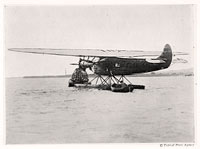
When they discovered that there was a woman on board, they more than made up for the lack of enthusiasm they had earlier shown. Soon, a crowd of over 2,000 people had gathered, busying the local constabulary. After welcome warm baths, they faced the growing crowd of reporters. Soon, preliminary stories were filed and the crew was allowed a quiet night's sleep.
They awoke to a wave of congratulatory telegrams, including one from President Coolidge:
TO THE FIRST WOMAN SUCCESSFULLY TO SPAN THE NORTH ATLANTIC BY AIR THE GREAT ADMIRATION OF MYSELF AND THE UNITED STATES.
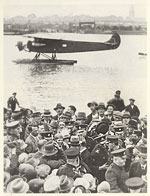
At 11 AM they took off for Southampton for a short stay, and then London, the final destination of the flight. The entire flight from Trepassey to Burry Port had taken 20 hours and 49 minutes officially. Amelia later authored a book that chronicled her life and the record of her flight and titled it "20 Hours and 40 Minutes", shortening the flight slightly.
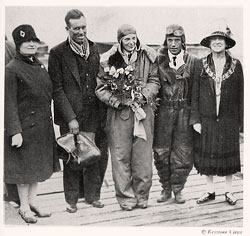
After the transatlantic flight, Amelia was in demand on the lecture circuit. George often scheduled as many as thirty lectures in thirty days in different cities. She opened buildings, gave interviews and numerous speeches that would finance future aviation projects. Although the schedule was hectic, it gave Amelia the opportunity to associate with many of the elite pilots of the day such as Charles Lindbergh and Commander Richard Byrd.
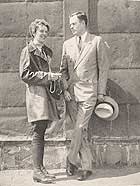
As a break from the hectic lecture schedule, Amelia and George planned a "vacation" in California. Their vacation conveniently coincided with the National Air Races. Amelia was excited about the trip because it finally gave her the opportunity to fulfill her dream of flying across the United States, the flight she had wanted to do four years earlier when she moved from California to Boston. George was not as excited about the trip as Amelia. He was not a flyer and was prone to air sickness, anxiety and fear of heights.
The first leg of the transcontinental flight went well until landing in Pittsburgh, Pennsylvania. As Amelia landed the plane, she hit an unmarked ditch, causing a ground loop that nearly flipped the aircraft. Repairs were slow and soon reporters learned of her transcontinental attempt. Oddly enough, she was the first woman to attempt an east to west flight. Needless to say, George completed the trip by train.
At this point in time, there were few organized airports in the Midwest. Also, there were also no standardized maps of country roads and small towns. Amelia had a hand drawn map pinned to her shirt, but it tore and blew away. Short of fuel, she was forced to land on the main street of a small town. She finally arrived in California in mid September.
Near the end of September, she set out on her return journey to the east coast. She had a rough forced landing in Utah and her aircraft had to be shipped to Salt Lake for repairs. She arrived in New York on October 16 as the first woman to make the round trip transcontinental flight.
Amelia became heavily involved in promoting flying for women. Many women were now beginning to fly the newer, larger aircraft and the opportunities were expanding for them. Amelia herself learned to fly larger aircraft, although the skill did not come quickly to her. In fact, after training with a Bellanca, the trainer saw such serious faults in her piloting skills that they refused to sell her one of their aircraft. She and George purchased a Lockheed Vega so that she could fly in the competitions in the top classes instead of the classes for the smaller planes she had flown to this point.

Amelia Earhart, Ruth Nichols,Louise Thadden
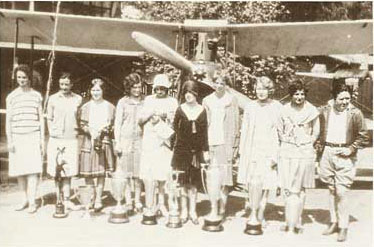
(L-R)Louise M. Thaden, Bobbi Trout, Patti Willis, Marvel Crosson, Blanch W. Noyes, Vera Dawn Walker, Amelia Earhart, Marjorie Crawford, Ruth Elder, and Florence "Pancho" Barnes the second leg, Marvel Cronon did a nose dive into the ground. Her body was found entangled in her parachute. Clair Fahy's plane was forced down in thick mesquite because of a wing brace failure. Thea Rashe was forced down due to sand in her fuel tank. Sabotage was suspected in these 3 incidents and the press was in a frenzy. Many people were demanding that the derby be stopped, but the derby organizers and the flyers were not among the objectors. The derby continued with many forced landings, which was not unusual for these times. Ruth Elder landed in a field of cattle and upon exiting her airplane, she exclaimed, "I certainly hope these are all cows." Margaret Perry took ill during the derby and was hospitalized in Texas with typhoid fever. Blanche Noyes looked back to see her plane on fire, landed in a field, threw sand on the fire to put it out and took off again to finish her day. The press was critical saying, "Women have proven conclusively that they cannot fly!" However, a higher percentage of the women finished this derby course in less time than any men's race to date. Louise Thadden took first place in her Travel Air, with Gladys O' Donnell a close second in her clipped wing Waco and Amelia took third place with her Lockheed Vega.
"Finishing a race, as in anything else, is as important as starting, and sixteen of the women crossed the white line at the end. This was the highest percent of "finishers" in any cross country derby, up to that time, for men or women."
Selection from:The Fun of It: Written by Amelia Earhart 1932.
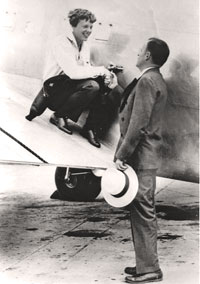
During the fall of 1930, Amelia planned to marry her publicist, George Putnam. They had planned to marry quietly and obtained their marriage license on November 8th. But, somehow the news leaked to the press and there was no hope of a quiet wedding. They applied for a waiver to their license and waited for the publicity to settle down. Finally, on February 7, 1931, they married. Amelia wore a simply cut brown suit with brown shoes and no hat. They borrowed George's mother's wedding ring for the ceremony because their schedules were so busy that they did not have the time to purchase their own. Amelia retained her name, which was rare in those days, for purposes of publicity.
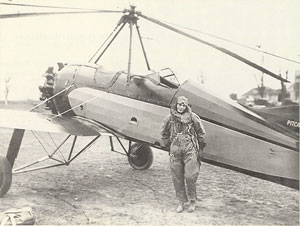
During December of 1930, Amelia made a test flight of an autogiro. At this point in time, she was the only woman to fly one. She set an altitude record at 19,000 feet in one on April 8, 1931. During May and June of that year, she attempted a transcontinental flight in one with dozens of publicity stops. She was hoping to be the first to succeed at transcontinental flight in an autogiro, but was disappointed to find that another pilot had completed the flight a week earlier. So, she prepared her "flying windmill" to make the return flight.
She demonstrated the unusual autogiros often. In September, at an airshow in Detroit, she crashed on landing.
George wrote,
"As I swung round I saw the giro, its rotors splintered, disappear in a cloud of smoke. I vaulted the rail and raced for the wreck. Never have I run so fast, until one of those guy wires caught my pumping legs exactly at the ankles. I did a complete outside loop, up into the air and over, landing full on my back...Coming to my senses, some of them at least, I saw AE emerge from the welter of dust (it wasn't smoke) and wave her hands in the air to show she was unhurt."George cracked three ribs in the accident. Amelia was unscathed.
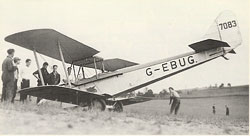
One morning, over breakfast, Amelia quietly, and unexpectedly, said to George, "Would you mind if I flew the Atlantic?" He knew she meant a solo flight. Several other women were considering and preparing for this flight, including Elinor Smith. The Vega was in top condition but secrecy was a must. Publicity stated that Amelia's Vega was being prepared for a polar flight. The fuselage was rebuilt to carry fuel instead of passengers. The wings were strengthened to carry fuel, as well. They prepared to carry 450 gallons of fuel for a 3200 mile range. The Vega received a new 500 hp Wasp engine to replace the older Wasp and a date was set to correspond to the five year anniversary of Lindbergh's flight, which would have been May 20 to 21, 1927 (1932).
No one had successfully flown the Atlantic alone since Lindbergh's accomplishment, although there had been several successful crewed flights. Amelia, and several other women pilots, felt that it was important to establish that a woman could fly the Atlantic alone, especially after a Liberty Magazine article titled, "Why I Believe Woman Pilots Can't Fly the Atlantic" by Lady Heath. This article hit the newsstand the day Amelia took off. Lady Heath's accompanying note read "...do make an appeal if you can for women not to fly the Atlantic, even if you can't use my scribble. It is madness for them to attempt it and at least the first dozen will be drowned...
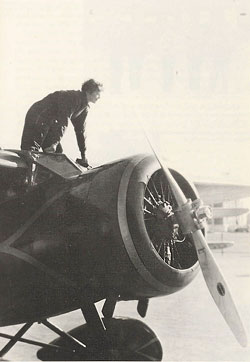
Amelia planned to vary Lindbergh's route to shorten it slightly. Her mechanics were concerned that she might not be able to endure the longer distance. The plan was to take off from Newfoundland instead of New York, as Lindbergh did, and consider the British Isles as the prime destination, Paris as a provisional destination and, after landfall, to land anywhere if she felt unable to continue.
The Vega was equipped with a drift indicator, aperiodic and gyroscopic compasses. The fuel system was rigged to balance the weight of the aircraft as the fuel was consumed for optimum weight distribution. The developer of this ingenious system was Major Edwin Aldrin, father to Apollo XI astronaut, Buzz Aldrin. At one point in time, Amelia was quoted, "I do not believe in luck. The best mascot is a good mechanic." Amelia practiced instrument flying as much as possible. She practiced "until I felt really confident of my ability to handle the ship, without looking outside the cockpit, that is, flying it solely with instruments."
The weather, again, played a determining role in the timing of this flight. Seven women had already died in their attempts at crossing the Atlantic due to either weather or mechanical failures. For the most part, their fate was unknown. The weather outlook on the 18th and 19th of May was poor. In fact, the report was disappointingly poor on the morning of the 20th. At about 2:30 PM, there was a sudden opening, so Amelia quickly gathered a few things and arrived at the airport at 2:55 PM. The Vega was airborne by 3:15 PM, headed for Harbour Grace, Newfoundland. Amelia later wrote of this time, "the actual doing of a dangerous thing, it seems to me, may require little courage. The preparation for it-the acceptance of the inevitable risks involved-may be a far greater test of morale."
Amelia and her mechanics arrived in Harbour Grace without incident and Amelia actually napped. At 6:30 PM, after the mechanics had made their final inspections and checked the latest weather reports, she was awakened to begin her flight. Her mechanic, Bernt Balchen, recalled in his diary, "She listens calmly, only biting her lip a little, as I go over with her the course to hold, and tell her what weather she can expect on the way across the ocean. She looks at me with a small lonely smile and says, 'Do you think I can make it?' and I grin back: 'You bet.' She crawls calmly into the cockpit of the big empty airplane, starts the engine, runs it up, checks the mags, and nods her head. We pull the chocks, and she is off..." She took off at 7:12 PM, local time, exactly on the anniversary date of Lindbergh's historic flight.
At first, the flight was uneventful. But, three hours into the flight, the altimeter failed. This was very unusual and forced Amelia to rely on her barograph and keep track of her ascent and descent to determine her altitude. She really had no accurate way of knowing her exact altitude, which is important to instrument flying.
Four hours into the flight, she ran into a severe lightening and thunder storm. She figured that the severity of the storm had to have pushed her off course. Then, a seam in the exhaust manifold failed due to a bad weld. Flames from fuel combustion were very visible in the darkness of night. She mentioned that, "she was sorry she had looked at the break at all because the flames appeared so much worse than they did in the daytime."
Later, she flew into clouds and decided to climb out of them. She climbed, slowly, for nearly a half hour before a thin film of ice appeared on her windshield. Instantly, the Vega was in a spin. She worked the controls to pull the aircraft out of the spin and finally regained control. The warmer temperatures at a lower altitude had melted the ice, but not before she was dangerously close to disaster. "How long I spun, I do not know. I do know that I did my best to do exactly what one should do with a spinning plane and regained flying control as the warmth of the lower altitude melted the ice. As we righted and held level again, through the blackness below I could see the whitecaps, too close for comfort." With no accurate idea of her altitude, she flew halfway between the fog and the ice until dawn.
About two hours before her estimated landfall, she noticed a fuel leak from the cabin fuel gauge. It was dripping onto her shoulder and she was concerned about fire with the manifold exposed and the fumes from the fuel. The split in the manifold was slowly growing, causing even more concern. At this point, she decided to put down at the first available opportunity. Warned of storms to her south, she altered her course slightly north thinking that she would see the southern tip of Ireland. She actually landed in Teelin Head, County Donegal on the northwest tip of Ireland and nearly missed Ireland altogether. She was unable to find an airfield, so she located a suitable pasture, circled several times and landed, hoping to avoid any cows. She landed safely, cut the switches, climbed out of the Vega and asked,
"Where am I?" The farm hand, Danny McCallion, answered, "In Gallagher's pasture."
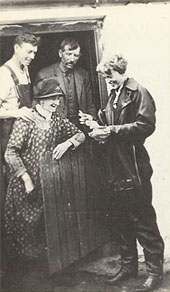
She had made her historic flight in 14 hours and 50 minutes, breaking the previous record of 16 hours and 12 minutes by a team of pilots. She became the second person to make the flight solo. Charles Lindbergh was the only other to make the solo flight until then. She was the first woman to cross the Atlantic solo. She became the first person to fly it twice. And she set the distance record for women.
Some of the pictures and information were obtained from: Twenty Hours, Forty Minutes and The Sound Of Wings
The Moffat Modeler's N-Scale Model Train Layout
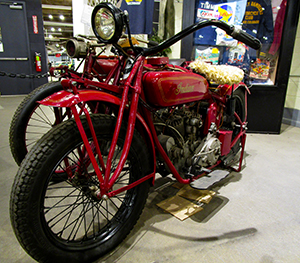
The Timme Motorcycle Collection
Come and see some incredible vintage Indian, Honda & other rare motorcycles! *Exhibits subject to change without notice*

Visit our Gallery
Make sure to visit our gallery. Our gallery features various die-cast models, art, and other artifacts related to transportation.